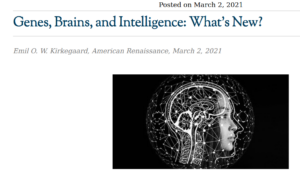See also previous posts: Race gaps in brain size in the very young, Of cats and dogs and men
Sometimes it’s said that race science is stuck in an old time when talking about brain variables. It’s true, almost all the studies are about crude global measures: total brain volume, brain weight (autopsies) etc. The reason for this is that few neuroscientists have the balls and desire to study race in modern, large datasets. But there are some exceptions worth mentioning.
Isamah et al 2010
-
Isamah, N., Faison, W., Payne, M. E., MacFall, J., Steffens, D. C., Beyer, J. L., … & Taylor, W. D. (2010). Variability in frontotemporal brain structure: the importance of recruitment of African Americans in neuroscience research. PloS one, 5(10), e13642.
Background
Variation in brain structure is both genetically and environmentally influenced. The question about potential differences in brain anatomy across populations of differing race and ethnicity remains a controversial issue. There are few studies specifically examining racial or ethnic differences and also few studies that test for race-related differences in context of other neuropsychiatric research, possibly due to the underrepresentation of ethnic minorities in clinical research. It is within this context that we conducted a secondary data analysis examining volumetric MRI data from healthy participants and compared the volumes of the amygdala, hippocampus, lateral ventricles, caudate nucleus, orbitofrontal cortex (OFC) and total cerebral volume between Caucasian and African-American participants. We discuss the importance of this finding in context of neuroimaging methodology, but also the need for improved recruitment of African Americans in clinical research and its broader implications for a better understanding of the neural basis of neuropsychiatric disorders.
Methodology/Principal FindingsThis was a case control study in the setting of an academic medical center outpatient service. Participants consisted of 44 Caucasians and 33 ethnic minorities. The following volumetric data were obtained: amygdala, hippocampus, lateral ventricles, caudate nucleus, orbitofrontal cortex (OFC) and total cerebrum. Each participant completed a 1.5 T magnetic resonance imaging (MRI). Our primary finding in analyses of brain subregions was that when compared to Caucasians, African Americans exhibited larger left OFC volumes (F 1,68 = 7.50, p = 0.008).
ConclusionsThe biological implications of our findings are unclear as we do not know what factors may be contributing to these observed differences. However, this study raises several questions that have important implications for the future of neuropsychiatric research.
Fan et al 2015
-
Fan, C. C., Bartsch, H., Schork, A. J., Chen, C. H., Wang, Y., Lo, M. T., … & Jernigan, T. L. (2015). Modeling the 3D geometry of the cortical surface with genetic ancestry. Current Biology, 25(15), 1988-1992.
Knowing how the human brain is shaped by migration and admixture is a critical step in studying human evolution [1 , 2 ], as well as in preventing the bias of hidden population structure in brain research [3 , 4 ]. Yet, the neuroanatomical differences engendered by population history are still poorly understood. Most of the inference relies on craniometric measurements, because morphology of the brain is presumed to be the neurocranium’s main shaping force before bones are fused and ossified [5 ]. Although studies have shown that the shape variations of cranial bones are consistent with population history [6 , 7 , 8 ], it is unknown how much human ancestry information is retained by the human cortical surface. In our group’s previous study, we found that area measures of cortical surface and total brain volumes of individuals of European descent in the United States correlate significantly with their ancestral geographic locations in Europe [9 ]. Here, we demonstrate that the three-dimensional geometry of cortical surface is highly predictive of individuals’ genetic ancestry in West Africa, Europe, East Asia, and America, even though their genetic background has been shaped by multiple waves of migratory and admixture events. The geometry of the cortical surface contains richer information about ancestry than the areal variability of the cortical surface, independent of total brain volumes. Besides explaining more ancestry variance than other brain imaging measurements, the 3D geometry of the cortical surface further characterizes distinct regional patterns in the folding and gyrification of the human brain associated with each ancestral lineage.
Altmann and Mourao-Miranda 2018
-
Altmann, A., & Mourao-Miranda, J. (2018. Evidence for bias of genetic ancestry in resting state functional MRI. Bioarxiv
Resting state functional magnetic resonance imaging (rs-fMRI) is a popular imaging modality for mapping the functional connectivity of the brain. Rs-fMRI is, just like other neuroimaging modalities, subject to a series of technical and subject level biases that change the inferred connectivity pattern. In this work we predicted genetic ancestry from rs-fMRI connectivity data at very high performance (area under the ROC curve of 0.93). Thereby, we demonstrated that genetic ancestry is encoded in the functional connectivity pattern of the brain at rest. Consequently, genetic ancestry constitutes a bias that should be accounted for in the analysis of rs-fMRI data.

